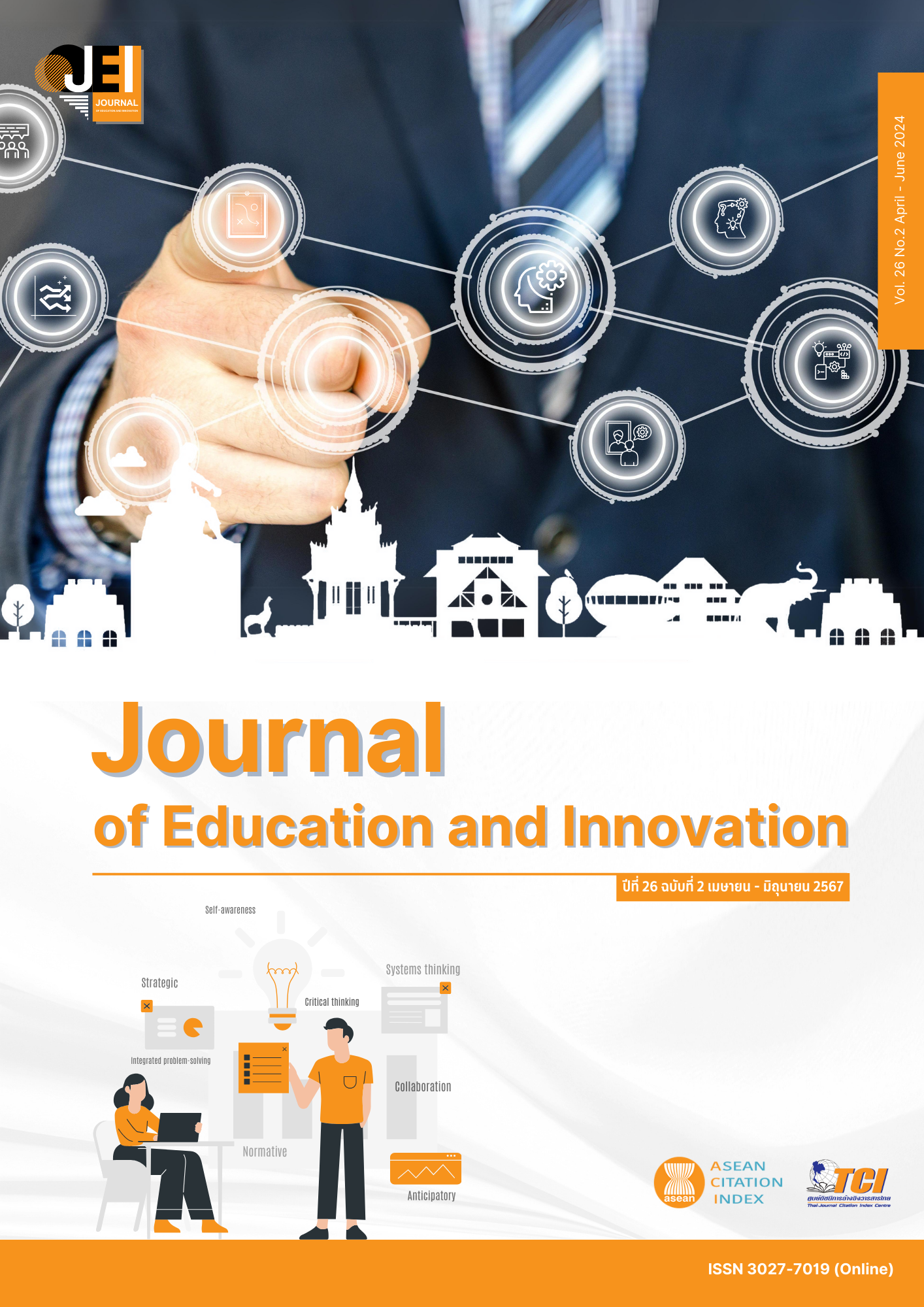THE DEVELOPMENT OF INFOGRAPHICS ON GOOGLE’S ONLINE PLATFORM TO ENHANCE ENGLISH GRAMMAR LEARNING ACHIEVEMENT OF STUDENT TEACHERS
Main Article Content
Abstract
The purposes of this research were: 1) to develop the infographics on Google’s online platform in order to reach the efficiency of the 80/80 threshold set, and the effectiveness index more than 0.50; 2) to examine the effects of using the infographics on Google’s online platform to enhance English grammar learning achievement of student teachers; and 3) to investigate the student teachers’ satisfactions towards teaching English grammar by using the infographics on Google’s online platform. The samples were two groups of student teachers in Faculty of Education at Suratthani Rajabhat University, who enrolled in the English for Communication Course in the semester 2 of the academic year 2022, selected by using the random sampling method. The random assignment was employed to specify the groups as the experimental group consisted of 30 student teachers, and the controlled group consisted of 29 student teachers. The research instruments were: 1) the developed infographics on the Google’s online platform; 2) twelve lesson plans of teaching English grammar by using the infographics on Google’s online platform; 3) twelve lesson plans of teaching English grammar by the traditional teaching method; 4) the English grammar learning achievement test; and 5) the questionnaire of student teachers’ satisfactions towards teaching English grammar by using the infographics on the Google’s online platform. The data were statistically analyzed using the efficiency (E1/E2), effectiveness index (E.I.), mean (M), standard deviation (SD), percentage (%), t-test, and effect size (Cohen’s d). The findings showed as follows:
1. The infographics on the Google’s online platform reached both the efficiency at 91.75/83.56 and the effectiveness index at 0.73 which were higher than the set criteria.
2. The English grammar learning achievement of the student teachers taught by using the infographics on the Google’s online platform was higher than the controlled group taught by the traditional teaching method at the .05 level of statistical significance with the huge effect size (Cohen’s d = 1.83), and the post-learning achievement in English grammar of the student teachers taught by using the infographics on the Google’s online platform was higher at the .05 level of statistical significance.
3. The student teachers’ satisfactions towards teaching the English grammar by using the infographics on the Google’s online platform were at the highest level (M = 4.56, SD = 0.02).
Article Details

This work is licensed under a Creative Commons Attribution-NonCommercial-NoDerivatives 4.0 International License.
The owner of the article does not copy or violate any of its copyright. If any copyright infringement occurs or prosecution, in any case, the Editorial Board is not involved in all the rights to the owner of the article to be performed.
References
Bowen, D. J. (1985). TESOL techniques and procedures. Rowley: Newbury House Publishers.
Brahmawong, C. (2013). Developmental testing of media and instructional package. Silpakorn educational research journal, 5(1), 7-20.
Brown, H. D. (2000). Principles of language learning and teaching. New York: Addison Wesley Longman.
Celce-Murcia, M., & Hilles, S. (1998). Techniques and resources in teaching grammar. Oxford: Oxford University Press.
EF Education First. (2022). CEFR and EF SET. Retrieved August 18, 2022, from https://www.efset.org/th/cefr
Faculty of Education, Suratthani Rajabhat University. (2022). Self-assessment report: SAR. Surat Thani: Faculty of Education, Suratthani Rajabhat University.
Google LLC. (2020). Products that drive education. Retrieved November 25, 2022, from https://edu.google.com
Jamjuree, D. (2020). Learning design for Gen Z learners. Bangkok: Graduate School, Srinakharinwirot University.
Kitrakarn, P. (2011). Research and education technology theory. Mahasarakham: Faculty of Education, Mahasarakham University.
Leavy, P. (2017). Research design: Quantitative, qualitative, mixed methods, arts-based, and community-based participatory research approaches. New York: The Guildford Press.
Lertbumroongchai, K. (2021). Hybrid learning. Retrieved December 20, 2022, from https://touchpoint.in.th/hybrid-learning
Milner, M., & Jenkins, R. (2015). World English 1. Boston: Cengage Learning.
Newsom, D., & Haynes, J. (2004). Public relations writing: Form and style. California: Wadsworth Publishing.
Oxford University Press. (2022). Oxford placement test. Retrieved August 18, 2022, from https://elt.oup.com/feature/global/oxford-online-placement/?cc=th&selLanguage=th
Phengsawat, W. (2009). Research and development. Sakon Nakhon Rajabhat University Journal, 1(2), 2-12.
Poovorawan, Y. (2020). Effects of COVID-19 pandemic on education. Retrieved December 24, 2022, from https://learningcovid.ku.ac.th/course/?c=7&l=4
Reiser, R. A., & Dempsey, J. V. (2018). Trends and issues in instructional design and technology. New York: Pearson Education.
Shinawatra, C. (2019). Prototyping. Retrieved December 21, 2022, from https://slideplayer.in.th/slide/16175027
Smiciklas, M. (2012). The power of infographics: Using pictures to communicate and connect with your audience. Indiana: Que Publishing.
SpyreStudios. (2013). The anatomy of an infographic: 5 steps to create a powerful visual. Retrieved November 29, 2022, from http://www.pearltrees.com/iwona.h./infographics/id7596374#item76090631
Suratthani Rajabhat University. (2017). General education Suratthani Rajabhat University 2017 revised edition. Surat Thani: Suratthani Rajabhat University.
Suratthani Rajabhat University. (2019). Internal quality assurance manual Suratthani Rajabhat University 2019. Surat Thani: Suratthani Rajabhat University.
Sysoyev, P. (1999). Principles of teaching English for specific purposes in Russia. English for specific purposes - Russia, 11, 13-15.
Thalheimer, W., & Cook, S., (2002). How to calculate effect sizes from published research: A simplified methodology. Work-learning research, 1-9.


